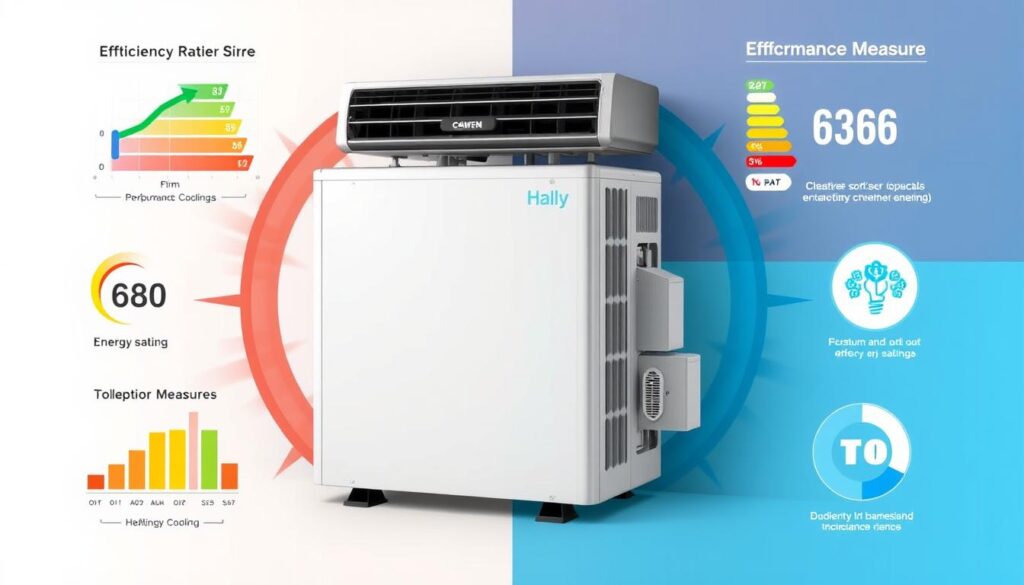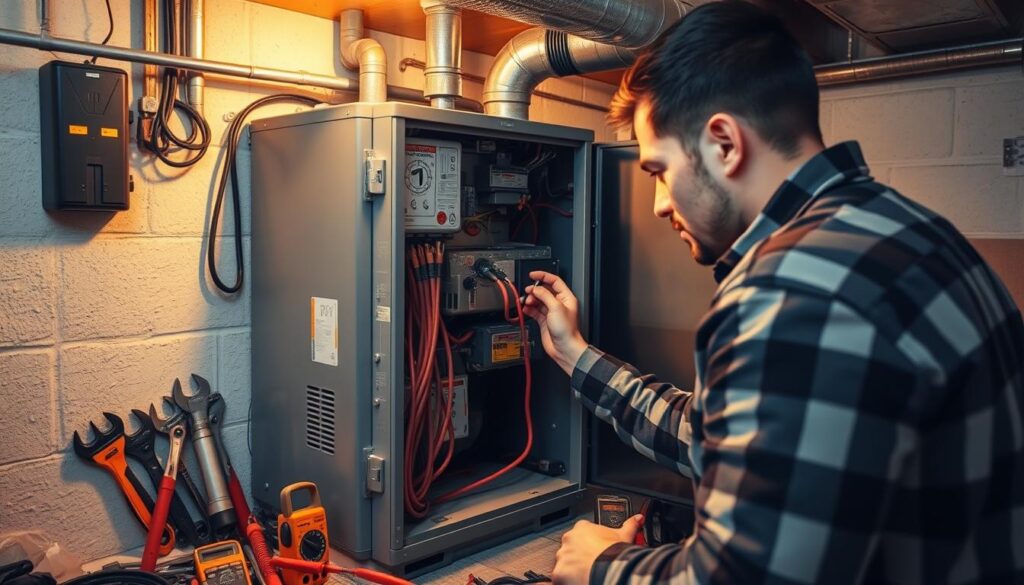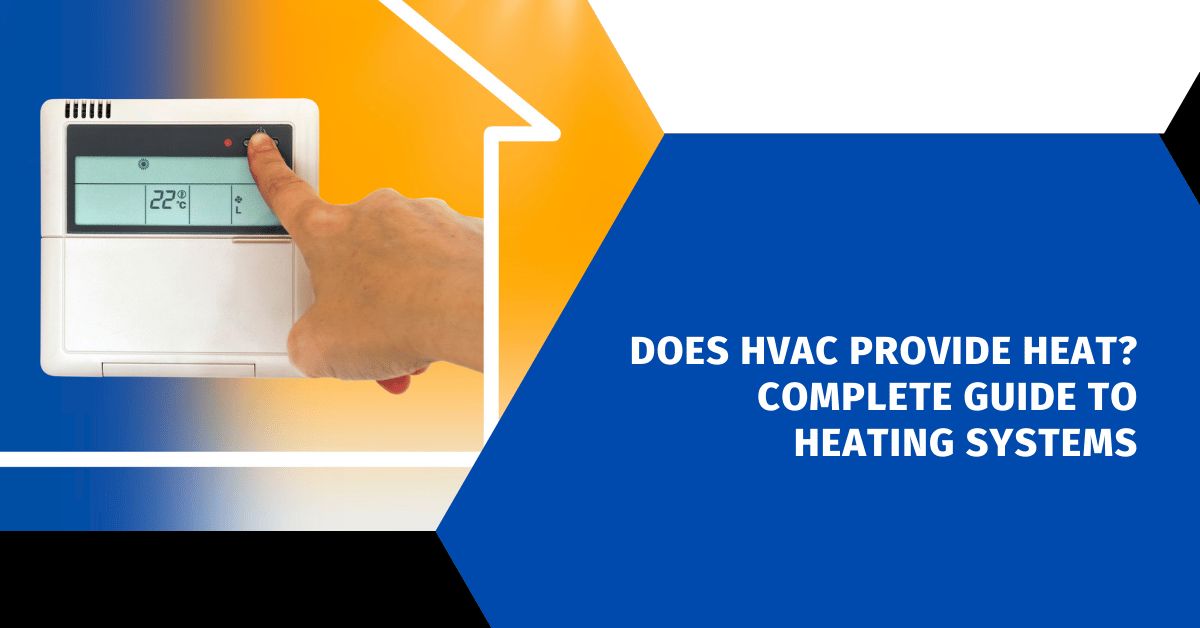Affiliate Disclosure
HVAC Guide Guys is a participant in the Amazon Services LLC Associates Program, an affiliate advertising program designed to provide a means for sites to earn advertising fees by advertising and linking to Amazon.
Does HVAC Provide Heat? As winter arrives, keeping your home warm and cozy is key. But have you ever thought about how your HVAC system heats your home? Learning about your heating system can make your home warmer and save you money on energy. Let’s explore the world of HVAC heating systems and find out how to keep your home warm all season.

Key Takeaways
- HVAC systems are crucial for keeping your home at a comfortable temperature and improving air quality.
- Heating systems in HVAC use different methods like furnaces, boilers, and heat pumps to warm your home in winter.
- Heat exchangers are important for safely and efficiently moving heat from the source to your air or water system.
- Regular maintenance and professional tune-ups are key to keeping your HVAC system running well and lasting longer.
- Knowing about the different heating systems and their energy sources helps homeowners choose the best one for their home.
Table of Contents
Understanding HVAC Systems and Heat Generation
HVAC stands for Heating, Ventilation, and Air Conditioning. It’s key for keeping places comfy, controlling humidity, and ensuring air quality. At its core, HVAC systems use heating components to spread warm air everywhere.
What is an HVAC System?
An HVAC system is a complex setup of equipment and ducts. It includes a heat source like a furnace or boiler, and air distribution tools like vents and ducts. Its main job is to make indoor spaces comfortable and healthy by managing temperature, humidity, and air quality.
Components of Heating Systems
- Heat generators: Furnaces, boilers, and heat pumps are common heat-generating components in HVAC systems.
- Heat exchangers: These critical devices transfer heat from the burning fuel to the air without allowing combustion gases to mix with the heated air, ensuring safe and efficient heating.
- Blowers and air ducts: Responsible for circulating the warm air generated by the heat source throughout the building.
The Role of Heat Exchangers
Heat exchangers are crucial in HVAC systems, especially in furnaces and boilers. They move heat from fuel to air safely and efficiently. This way, the warm air can be spread without mixing with harmful gases.
In electric furnaces, heat exchangers are also key. They help distribute warm air well, without needing to burn fuel. This makes the HVAC system work better and use less energy.
Explore Our HVAC Shop
Looking for top-rated HVAC tools, parts, and accessories? Visit our shop and find the perfect solution for your needs.
Visit the ShopDoes HVAC Provide Heat? Understanding the Basics
HVAC (Heating, Ventilation, and Air Conditioning) systems keep our homes comfortable all year. They are not just for cooling. They also provide heat.
The furnace is a key part of an HVAC system. It heats the air and sends it through ducts. Furnaces use natural gas, propane, or electricity and have an AFUE rating.
Boilers are another heating option. They heat water and send it to radiators or underfloor heating. Older homes often have boilers, which use natural gas, oil, or electricity.
Heat pumps are special. They can heat and cool. They move heat from outside or the ground into your home. This makes them efficient and good for milder climates.
Choosing the right heating system depends on many things. This includes the local weather, your home’s size and layout, and your energy goals. An HVAC contractor can help pick and install the best system for your home.
“HVAC systems play a crucial role in providing comfortable indoor environments, and the choice of heating system is a key component in ensuring energy efficiency and tailored comfort.”
HVAC systems, including furnaces, boilers, and heat pumps, are vital for heating homes. Knowing how they work helps keep your home warm and cozy all year.
Explore Our HVAC Shop
Looking for top-rated HVAC tools, parts, and accessories? Visit our shop and find the perfect solution for your needs.
Visit the ShopTypes of Heating Systems in Modern HVAC
Home heating systems come in many types for modern HVAC setups. You can choose from forced-air furnaces, heat pumps, or boiler and radiator systems. Each has its own benefits for different needs.
Forced-Air Furnaces
Forced-air furnaces are common in American homes. They use a fan to spread heated air through ducts. You can find them powered by natural gas, electricity, or oil, with gas being the most common.
Heat Pumps and Their Operation
Heat pumps offer both heat and cool, making them versatile. Air-source heat pumps are growing fast, while geothermal heat pumps are super efficient. They move heat, not make it, saving energy.
Boiler and Radiator Systems
Boiler and radiator systems are more common in Europe but found in some American homes. They heat water in a boiler, which then warms the house through pipes and radiators.
Radiant heating systems warm floors, walls, or ceilings directly. They’re great for energy-efficient homes because they don’t need air circulation.
| Heating System Type | Key Characteristics | Efficiency Considerations |
|---|---|---|
| Forced-Air Furnaces | Use a fan to circulate heated air through ducts | Gas-fired models are the most common, with the best furnaces achieving over 90% efficiency |
| Heat Pumps | Versatile heating and cooling systems, with air-source and geothermal options | Geothermal heat pumps are the most energy-efficient HVAC systems available |
| Boiler and Radiator Systems | Use a boiler to heat water, which is then circulated through a network of pipes and radiators | Boilers generally use natural gas or heating oil, with modern models achieving high efficiency |
| Radiant Heating | Deliver heat through floors, walls, or ceilings, warming objects and people directly | Provide an energy-efficient heating solution by eliminating the need for air circulation |
Choosing the right heating system is important for comfort and energy savings. Knowing about types of heating systems helps make a good choice. Whether it’s a forced-air system, heat pump, or boiler and radiator or radiant heating, the right one can greatly improve your home.
How Heat Distribution Works in HVAC Systems
Heat distribution in HVAC systems is key to your comfort and system efficiency. There are several ways to distribute heat, each with its own benefits.
The most common method is ductwork. Warm air circulates through air ducts in your home. A blower fan pushes the air into different rooms.
Radiant heating warms surfaces like floors or walls directly. As these surfaces heat up, they warm the air around them. This creates a comfortable warmth.
Hydronic systems use hot water in pipes to warm radiators or underfloor heating. This method is efficient because water holds heat better than air. It provides consistent warmth.
Effective heat distribution depends on proper system design, installation, and maintenance. This includes duct sizing, insulation, and airflow optimization. It ensures heat reaches all areas evenly and efficiently.
| Heating System Type | Heat Distribution Method | Key Considerations |
|---|---|---|
| Forced-air Furnace | Ductwork | Duct sizing, insulation, airflow optimization |
| Radiant Heating | Warm Surfaces | Proper floor or wall insulation, even heat distribution |
| Hydronic Systems | Hot Water Circulation | Pipe sizing, insulation, water flow optimization |
Understanding different heat distribution methods helps homeowners choose the best HVAC system. This ensures a comfortable and energy-efficient home.
Explore Our HVAC Shop
Looking for top-rated HVAC tools, parts, and accessories? Visit our shop and find the perfect solution for your needs.
Visit the ShopEnergy Sources for HVAC Heating
There are many ways to power your home’s heating. Natural gas and propane are common choices for furnaces and boilers. They are efficient and save money.
Looking for something greener? Electric heating, like resistance heating and heat pumps, is a clean option. Heat pumps are especially good, using 61% less energy than others.
Natural Gas and Propane Systems
Natural gas and propane are top picks for heating, especially in cold places. They are reliable and cost-effective. Many homeowners choose them for their efficiency.
Electric Heating Options
Electric heating, including resistance heating and heat pumps, is a clean choice. Heat pumps are getting more popular. They work well even in cold, with some models efficient up to 300%.
Renewable Energy Solutions
Want to help the planet? Geothermal heat pumps and solar thermal systems are great alternatives. Geothermal pumps are very efficient, using 61% less energy and lasting 50 years. Solar thermal systems also cut energy use by 40% and carbon emissions by 50%.
“The choice of energy source for your HVAC system can have a significant impact on both your operating costs and environmental footprint. Understanding the various options available can help you make an informed decision that aligns with your needs and priorities.”
Efficiency Ratings and Performance Measures
Efficiency ratings are key for HVAC systems. They help homeowners see how well their heating and cooling work. Two important metrics are the Annual Fuel Utilization Efficiency (AFUE) and the Seasonal Energy Efficiency Ratio (SEER).
The AFUE rating shows how well furnaces and boilers use fuel. A higher AFUE means more energy savings. For instance, the most efficient Trane gas furnace has an AFUE of 97%.
The SEER rating checks how well air conditioners and heat pumps cool. The new SEER2 standard requires a minimum of 13.4 or higher in some areas. This ensures better cooling performance. The Heating Seasonal Performance Factor (HSPF) also measures heat pump efficiency. Now, the U.S. Department of Energy requires a minimum HSPF2 of 7.5 or higher.
| Efficiency Metric | What It Measures | Minimum Standard | High-Efficiency Example |
|---|---|---|---|
| AFUE | Furnace and boiler efficiency | 80% | Trane gas furnace: 97% |
| SEER2 | Air conditioner and heat pump cooling efficiency | 13.4 or higher | N/A |
| HSPF2 | Heat pump heating efficiency | 7.5 or higher | N/A |
Knowing these ratings helps homeowners choose better HVAC systems. High-efficiency equipment means more savings, comfort, and a greener home.

Explore Our HVAC Shop
Looking for top-rated HVAC tools, parts, and accessories? Visit our shop and find the perfect solution for your needs.
Visit the ShopCommon Signs Your Heating System Needs Attention
Keeping your home’s heating system in good shape is key for comfort and energy savings. Even the best HVAC systems can run into problems. Knowing the common signs can help you fix heating system maintenance issues before they get worse.
Warning Signs of Malfunction
Unusual noises like banging or squealing from your heating system might mean something’s wrong. This could be with the blower motor or burner. If some rooms are warmer than others, it might be a thermostat, ductwork, or heating unit problem.
Age-Related Issues
Furnaces usually last 15-20 years, and heat pumps about 15 years. As your system gets older, it might break down more often and use more energy. Regular heating system maintenance can help it last longer, but eventually, it will need to be replaced.
Performance Indicators
If your heating system turns on and off too much, or if some rooms are colder than others, it’s a sign of trouble. Short-cycling can also make your energy bills go up without using more energy, showing it’s not working well.
Regular maintenance and quick HVAC troubleshooting can stop many problems. Being quick to fix issues can keep your heating system running well for a long time. This way, you can avoid big furnace repair costs and keep your home cozy and energy-efficient.
| Issue | Potential Cause | Recommended Action |
|---|---|---|
| Unusual Noises | Blower motor, burner, or other internal component issues | Schedule professional HVAC troubleshooting to diagnose and repair the problem |
| Inconsistent Heating | Thermostat, ductwork, or heating unit malfunction | Inspect and address any issues with the heating system components |
| Frequent On-Off Cycling | Thermostat problems, airflow issues, or malfunctioning components | Perform heating system maintenance and consider professional HVAC troubleshooting if the problem persists |
| Increased Energy Bills | Loss of system efficiency due to various issues | Schedule furnace repair or system replacement to restore efficiency and reduce energy consumption |
Essential Maintenance Tips for HVAC Heating
Keeping your HVAC system in good shape is key for efficient heating and lower energy bills. Regular HVAC maintenance helps your system last longer and work better.
Changing your air filters every 1-3 months is crucial. Dirty filters block airflow, making your system work harder and possibly causing damage. Also, make sure vents and registers are clear for good air flow.
Get a furnace tune-up every year, usually in fall. A pro will check electricals, oil parts, and gas connections. This helps catch problems early and keeps your system running smoothly.
Good insulation and air sealing around your home’s openings can boost heating efficiency. Leaks make your system work harder, raising bills and lowering comfort.
By following these tips, your HVAC system will run efficiently, last longer, and save you money. Regular care is a smart investment for your comfort and wallet.

Explore Our HVAC Shop
Looking for top-rated HVAC tools, parts, and accessories? Visit our shop and find the perfect solution for your needs.
Visit the ShopChoosing the Right Heating System for Your Home
Choosing the right heating system for your home is important. You need to think about energy efficiency, long-term costs, and your home’s size and climate. The right choice can make your home more comfortable and save you money on bills.
Start by looking at your home’s size and the local climate. In places like Austin, Texas, with mild winters, a gas furnace or heat pump might be best. But in colder areas, like Northeast Ohio, you might need a more powerful system, like a high-efficiency gas furnace or a geothermal heat pump.
Energy efficiency is key. Look for systems with high AFUE ratings. These systems use less energy and can save you money in the long run. Even if they cost more upfront, the savings are worth it.
- Gas furnaces are a popular choice in Austin due to their efficiency in quickly warming a home.
- Heat pumps may not perform as efficiently during extremely cold weather in Austin but are still a viable option for most of the year.
- Radiant heating systems are a great choice for Austin, offering consistent and efficient warmth without ductwork.
Think about your budget too. Gas furnaces are often cheaper to buy than heat pumps or radiant systems. But, heat pumps and radiant systems can save you money over time because they use less energy.
Also, consider how much maintenance each system needs. Furnaces need regular filter changes and inspections. Heat pumps and radiant systems usually need less maintenance.
By considering these factors, you can find the HVAC system that’s right for you. It should be energy-efficient, comfortable, and cost-effective in the long run.
Conclusion
HVAC systems are key for keeping homes and businesses warm and comfy. Knowing about different heating systems and how to maintain them helps you save energy. This ensures your indoor space is cozy.
Choosing energy-saving HVAC options like heat pumps and smart thermostats can cut down on bills. It also helps the planet. Regular checks and updates to your system keep it running well. This boosts your comfort and energy efficiency.
When you’re building or updating your HVAC, knowing the latest tech is important. It helps you choose systems that save energy and last long. This way, you get a warm, efficient space for your family or business.

